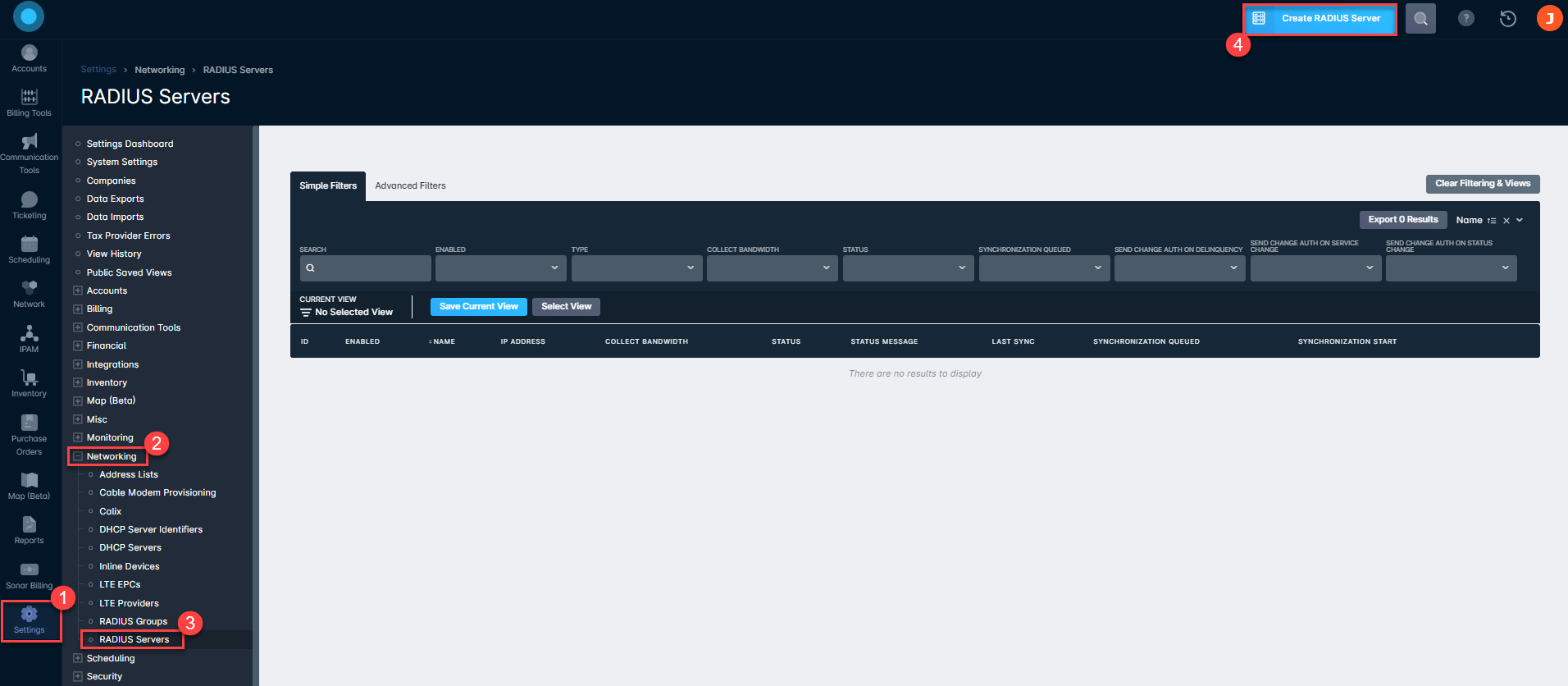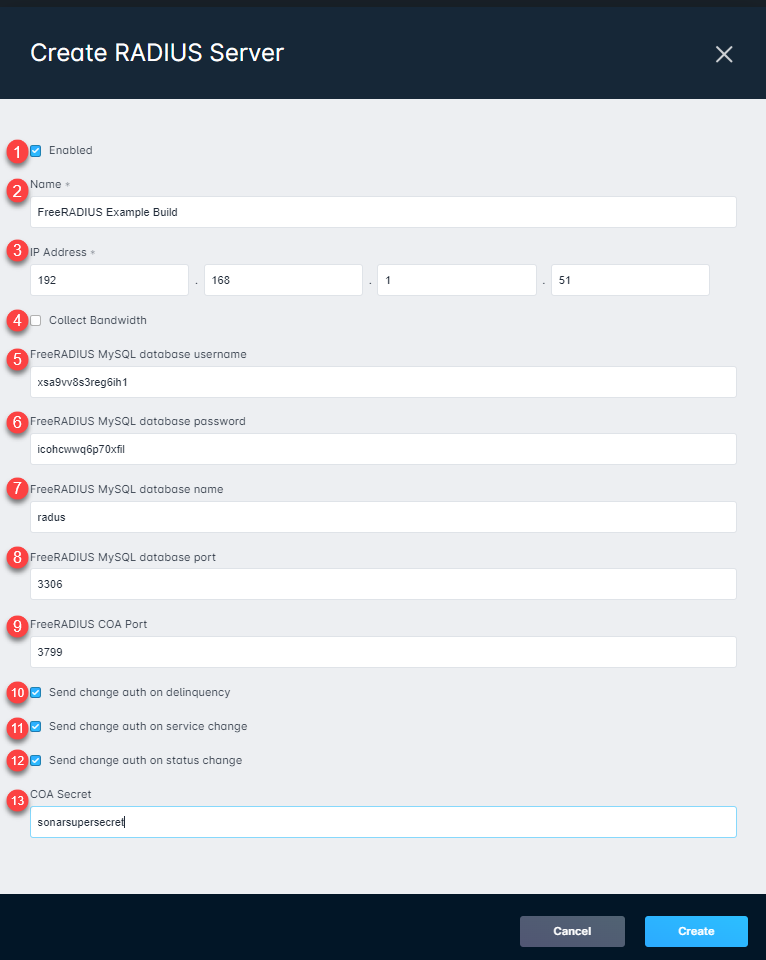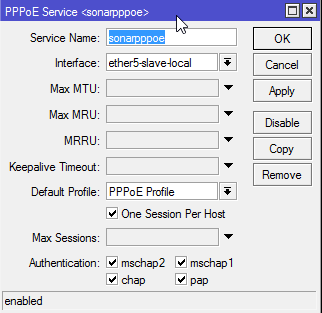Our Products & Services
Getting Started
First Time Setup
Getting Started With Jobs
Getting Started with Accounts
Getting Started with Inventory
Getting Started with Ticketing
Setting Sonar up for Billing
Baseline Configuration
How To: Using Sonar's Customer Portal
User Specific Resources
Accounts
Account Groups: Overview & Example Use Cases
Account List View: Overview
Account Management View: Overview
Account Overview Customization
Account Statuses: Overview & Example Use Cases
Account Types: Overview & Example Use Cases
Anchor & Linked Serviceable Addresses: Overview and Best Practices
Archiving an Account: Overview
CPUC Fixed Broadband Deployment by Address
Child Accounts: Best Practices & How Tos
Creating a New Account
Direct Messages: Overview
Disconnecting an Account
Disconnection Reason Management: Overview
Exploring Task Groups
FCC Broadband Data Collection (BDC) Filings: How Sonar Can Help
FCC Data Exports: General Overview and Usage
Future Serviceable Addresses: Overview
Lead Intake Form Processing
Notes: Best Practices & Use Cases
Scheduled Events: Overview & Use Cases
Serviceable Addresses: Overview and Usage
Specify Account ID upon Creation
Tasks & Task Templates: Overview
Using Sonar's FCC Broadband Label Generation Tool
Billing
ACH Batching: Overview
Accounts in Vacation Mode
Avalara: Overview & Setup
Batch Payments & Deposit Slips: Overview
Billing Calculator
Billing Defaults
Billing Settings
Building Packages
Building a Data Service
Canadian ACH tool
Changing Service Pricing in Sonar: Best Practices
Considerations When Using Avalara with Voice Services
Creating Discounts for Services and Packages
Delinquency Billing Best Practices
Delinquency Exclusions: Overview and Use Cases
Dual Data Services: Overview
Email Invoice Batch: Overview
General Ledger Codes: Overview
General Transactions: Best Practices
How Sonar Prorates Billing
How to Take Bank Account Payments
How to: Adding a Service to an Account
Invoice Templates: Overview
Leveraging PayPal as a Payment Method in Sonar
Manual Transactions
Multi-Month Billing & Multi-Month Services
Print to Mail
Printed Invoice Batches: Overview
Services: Overview
Setting Up Payment Methods and Taking Payments
Setting up Bank Account & Credit Card Processors
Taxes Setup
Usage Based Billing Policies: Overview and Usage
Usage Based Billing Policy Free Periods: Overview and Usage
Using Tax Exemptions - How To
Communication
Communications: Call Logs Overview & Best Practices
Communications: Messages Overview
Email Variables & Conditions
Message Categories: Overview & Use Cases
Phone Number Types: Overview and Use Cases
Saved Messages: Overview
Setting up an Outbound Email Domain
Trigger Explanations
Triggered Messages: Setup
Using Outbound SMS
Using the Mass Message Tool
Companies
How to: Setting Up a Company in Sonar
Managing Multiple Companies in Sonar: Best Practices
Rebranding your Sonar Instance
Financial
Contract Templates
Invoice Attachment Use Cases & PDF Examples
Invoice Messages: Overview & Use Cases
Invoices in Sonar: Examples, Creation & Contents
Integrations
Atlas Digital CORE Integration
Calix Cloud Data Field Mappings
Calix SMx Integration: Overview
CrowdFiber Integration
External Marketing Providers
GPS Tracking Providers: Overview
GoCardless Integration: Overview & Setup
How to Connect Cambium to your Sonar Instance
How to Connect Preseem to your Sonar System
How to: Using Webhooks in Sonar
Integrating with Calix Cloud
RemoteWinBox - Integration with Sonar
Sonar Retain: AI-Powered Customer Retention & Quality Intelligence
The Sonar Field Tech App
Tower Coverage Integration: Overview
VETRO FiberMap V2 Integration: Overview
VETRO FiberMap V3 Integration: Overview
Webhooks in Sonar: Basic PHP Example
iCalendar Integration
Inventory
Inventory List View: Overview
Inventory Model Management: General Overview
Network Inventory: How-to & Usage Guide
Segmentable Inventory: How-to & Usage Guide
Setup of Inventory: Manufacturers, Categories, and Assignees
Tracking and Using Consumable Inventory
Jobs
Applying Task Templates to Jobs
Edit Job Options
Example Jobs & Templates
Geofences: Overview
Job Types: Best Practices
Jobs and Scheduling: Overview
Scheduling How-to: Creating and Booking a Job
Scheduling Week View: Overview
Setting Up Schedules General Overview
Mapping
Misc.
Combining Custom Fields & Task Templates for Information Storage
Custom Fields Overview & Use Cases
Custom Links: Overview
Task Templates Overview & Use Cases
Monitoring
Building Alerting Rotations
Building a Monitoring Template
Poller Troubleshooting
Pollers: General Overview, Deployment Strategy, Build Out & Setup
Networking
Adtran Mosaic Cloud Platform Integration: Overview
Assigning RADIUS Addresses
Assigning an IP Address Using Sonar's IPAM: How to
Automating IP Assignments, Data Rates, and Network Access in Sonar
Building Address Lists
Building RADIUS Groups
Building a Device Mapper
Cable Modem Provisioning
Controlling Customer Speeds with Sonar: General Overview
DHCP Delivery
Data Usage Available Methods
Finding your OIDs
FreeRADIUS 3: Build-Out & Integration
How Sonar Communicates - Egress IPs Explained
IP Assignments & Sonar
IPAM: Basic Setup
IPAM: Overview
LTE Integration
MikroTik as an Inline Device: Integration With Sonar
MikroTik: Controlling Access
MikroTik: Controlling Speeds
MikroTik: Setting Up a Sonar Controlled DHCP Server
Netflow On-Premise Integration: Setup and Overview
Network Dashboard: Overview
Network Sites: Management View Overview
PacketLogic: Integration With Sonar
Pulse, Polling, and PHP
RADIUS: Build-Out & Integration with Sonar
RADIUS: Building Reply Attributes
Setting Up CoA Proxy
Sonar Flow
Sonar IP Addressing
Using Multiple Network Devices in Sonar
Purchase Orders
Release Notes
Reporting
Enhanced Business Intelligence - Tips & Tricks for Advanced Users
How To Enhance Your Reporting With Custom Field Data
Report Licenses
Sonar's Business Intelligence: Overview
Understanding Sonar Reports
Using Sonar DataConnect to Connect BI Applications with Your Sonar Instance
Security
Application Firewall: General Overview and Best Practices
Auth0: Overview
Multi-Factor Authentication: Overview
Password Policy In Depth
Removing a Terminated Employee In Sonar
Role Creation using GraphiQL
User Role Creation & Best Practices
Users: Overview
Sonar Billing
sonarPay
sonarPay Canada Disbursements: Overview
sonarPay Chargebacks & Disputes: Overview
sonarPay Disbursements: Overview
sonarPay Monthly Statement: Overview
sonarPay Overview
sonarPay Reversals, Voids, & Refunds: Overview
sonarPay: Token Migration Process
System
A Deeper Dive into the New Sonar API
API Calls Using Third Party Applications: Personal Access Tokens
Browser Compatibility and Minimum Hardware Requirements for Sonar
Consuming the Sonar API
Controlling Your Landing Page: Personal Preferences
Customizing Your Customer Portal
Date/Time Picker: Overview
Dynamic Time Zones in Sonar
Filtering: Overview
Frequently Used Terms
Getting Your Data into Sonar
GraphQL Rate Limiting Overview
How To Use GraphiQL to Understand the Sonar API
How Your Data is Backed Up
How to Best Use Global Search
Interacting with Files via the API
Introducing the New Sidebar
Main Menu: Overview
Mutations in the Sonar API
Notification Preferences
REST API Wrappers for V1 Compatibility
SMS Notifications
Sonar's Rich Text Editor
System Settings: Overview
The New Sonar API
Troubleshooting the Customer Portal
Upgrading your Ubuntu OS - Customer Portal Upgrades
User Profile: Your Personal User Settings
Ticketing
Advanced Ticketing Features
Canned Replies Examples & Templates
Canned Reply Categories
Exploring Ticket Groups
How Sonar Manages Spam Tickets
How to Integrate Inbound Mailboxes with Slack
Inbound Mailboxes Example Build
Ticket Category Families & Ticket Categories: Overview
Ticket Resolution Reasons: Overview
Ticketing: Overview
Using Parent Tickets
Voice
API Changes for Voice Billing
Best Practices to Remain CPNI Compliant
Billing Voice Services in Sonar
Deploying Voice Services in Sonar
Working With the Sonar Team & Additional Resources
Sonar's Security Practices & Certifications
Sonar and General Data Protection Regulation (GDPR)
Sonar's Security Strategies
Technical Security Overview
Best Practices for Fast Tracking a Support Request
Feedback Portal / Suggest a Feature
Learning with Sonar: Tools and Resources
New Client Training Overview
Sonar Casts Table of Contents
Submitting Bugs vs. Feature Requests
The Sonar Community Forum
The Sonar Status Page
Third Party Customer Support Referrals
- All Categories
- Networking
- RADIUS Integration with Sonar
RADIUS Integration with Sonar
 Updated
by Jennifer Trower
Updated
by Jennifer Trower
Building the RADIUS Server
To build the RADIUS server, please see instructions on the GitHub repository FreeRADIUS 3 Genie. The instructions below pick up where those leave off.
Note that you will need to add Sonar's egress IP address to your Genie NAS configuration, specifying the CoA secret that you will use in step 2 below.
Linking your FreeRADIUS server to Sonar
Once this configuration is done, we need to add the RADIUS server into Sonar.
- Inside your Sonar instance, navigate to Settings → Networking → RADIUS Servers and click the blue “Create” button in the top right.

- Fill in the Create RADIUS Server settings, using the FreeRADIUS MySQL database credentials generated by the FreeRADIUS Genie setup.

RADIUS Server creation field details
1. The Enabled checkbox will determine if this RADIUS Server will be used by Sonar for network and connection management. If the server is not enabled, Sonar won't send any request to it.
2. The Name field allows you to add an identifiable name to the server within your Sonar instance.
3. The IP Address field is required in order for your Sonar instance to know where to send requests.
4. Collect Bandwidth should be enabled if you want accounting data from sessions to be reported into Sonar as data usage. The usage from RADIUS will be forwarded to the account where that RADIUS username is stored.
5. The FreeRADIUS MySQL database username field is where the username provided in step 10 will be entered.
6. The FreeRADIUS MySQL database password field is where the password provided in step 10 will be entered.
7. The FreeRADIUS MySQL database name field is where you provide the defined database name to Sonar. In this example, the database name is "radius".
8. The FreeRADIUS MySQL database port is the configured network port that allows remote access to your MySQL database. In this example, the database port is "3306".
9. The FreeRADIUS CoA port is the configured network port that allows communication with the RADIUS server when Change of Authorization changes occur.
10. The "Send change auth on delinquency" toggle will enable or disable sending a request to your CoA proxy when an account enters a delinquent state.
11. The "Send change auth on service change" toggle will enable or disable sending a request to your CoA proxy when an account experiences a change of service.
12. The "Send change auth on status change" toggle will enable or disable sending a request to your CoA proxy when an account changes status.
13. The COA secret allows Sonar to connect to your CoA Proxy to effect auth changes.
Basic PPPoE configuration
Once this is done, you'll have a basic setup in place to enable PPPoE. Here's a quick tutorial on setting up a simple PPPoE configuration on a MikroTik router.
First, we need to set up our IP pools. These should correspond to IP pools you have created in your Sonar IPAM - refer to IPAM: Setup, Policy, & Best Practices for details on this! To configure pools, navigate to IP > Pool in your MikroTik. You can create as many IP pools here as you need, and chain them together so that if one pool is full, the next one is used. You can statically assign IPs to users from within Sonar by associating an IP with their RADIUS account. If you don't do this, then an IP will be selected from an available pool when the client connects, and Sonar will dynamically learn that IP and enter it as a soft assignment inside Sonar.

The pool configuration is pretty simple - a start IP, an end IP, and the next pool to use if this one is full.
Once you've configured your pools, click PPP in the menu on the left and then click the Profiles tab. Click the + button to create a new profile.
We're going to configure a very basic profile. Enter a name, select a local address to use for the profile (in this example, I used the first IP in the subnet for my pool - note that this IP is not included in my pool range!) and for remote address, select your first pool. Enter some DNS servers to assign to users, and under the Limits tab, set a session timeout. This will disconnect users after a certain period of time and they will have to reconnect. If you want to allow infinite sessions, don't set a timeout. Something like 24 hours is a reasonable setting if you want to have a timeout value.

Once your profile is configured, click the Secrets tab, and click the PPP Authentication&Accounting button.

Make sure Use Radius is checked, and that Accounting is checked. Make sure Interim Update is set to a reasonable value in minutes, as this is how frequently this MikroTik will send accounting data to your RADIUS server.
How Interim Updates work with Sonar
While the connection will be established and service will be delivered to the customer, you won't be able to hit the Disconnect button until the first interim update. If a disconnect is attempted on a session that hasn't completed an Interim Interval, the following error will occur:

If you make this too short and you have a lot of clients, your server may become overloaded, while setting it too high will result in data being sent infrequently. The shorter the time, the more often accounting data will be sent to the RADIUS server, and the more frequently you'll see updates as to users' data usage in Sonar. If you have a very small network (a few hundred users) you can probably set this to a low value (1-5 minutes) without much impact. For larger networks, set this to at least 15 minutes - you may need to increase it even more for very large networks!
Now click the PPPoE Servers tab, and click the + button to create a server.

Enter a name for the server, select the interface that your clients will be connecting on, and select the profile we created earlier. If you only want to allow one PPPoE session per host (which you probably do!) check One Session Per Host. Make sure all the authentication options at the bottom are checked.
You now have a very basic, functioning PPPoE server. Login to your Sonar instance, navigate to a user account, and access the Network tab, and then the RADIUS tab. Create a new RADIUS account and note the username and password.
Now, back in the MikroTik, Click the Active Connections tab and try connecting using a PPPoE client, authenticating using the credentials you just created in Sonar. You should be assigned an IP from the pool, and the connection will show up in the list! To assign a static IP, navigate back into Sonar, go to the Network tab on an account, and then IP Assignments. Assign an IP to the RADIUS account, and then disconnect and reconnect your PPPoE client. You will be assigned the static IP you selected.
